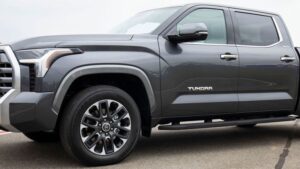The Biden administration is shooting for 50% of all new car sales to be electric vehicles by 2030. Thanks to generous state and federal on-the-spot rebates, local dealers are gearing up for a sales boom.
By Rina Torchinsky, Forbes Staff
The banner across the the top of the website for Larry H Miller Chrysler Dodge Jeep Ram 104th reads: “EV in Colorado: Up To $12,500 in Total Credits!…Available Now!” Despite rising auto loan rates and a skittish economy, general manager Brent Wood is in an enviable position because his Denver area dealership is located in one of the friendliest electrical vehicle states in the nation. As the holiday shopping season approaches, Wood will be showcasing plug-in hybrid electric vehicles (PHEV) – the Jeep Wrangler 4xe , Jeep Grand Cherokee 4xe and a hybrid Chrysler Pacifica.
“It’s like the Apple computer when it came out,” says Wood. “The excitement, the energy, the enthusiasm of the product is definitely there.”
In Colorado, a state vehicle exchange program can bring up to $6,000 in on-the-spot discounts on a plug-in hybrid like the Jeep Wrangler. Additional federal tax credits can chop off $3,750 more. Starting in 2024, drivers can can snag up to $13,500 in discounts at the time of purchase for a full blown battery powered electric vehicle (BEV) in Colorado.
The Centennial State is one of nine states that offer electric vehicle tax credits or rebates, and that’s on top of the federal tax credit of up to $7,500, which can generally be combined. Next year, the federal incentives will no longer require buyers to apply for them at tax filing time. The discounts will be immediate, at the dealership.
“The sticker shock of a new EV for a long time has been a significant barrier to adoption,” says Spencer Burget of Atlas Public Policy, referring to the premium cost of electric vehicles. “You have widely available uncapped federal incentives, you have increasing state incentives. We’re really quickly approaching upfront cost parity.”
In August 2021, the White House set lofty goals for electric vehicles: By 2030, President Biden wants half of all new vehicle sales to be electric. Currently, that figure sits around 8%, according to data from Cox Automotive. But electric vehicle sales are expected to boom – and a report from Goldman Sachs suggests the White House goal could be in the cards.
More than 800,000 electric vehicles were sold in 2022, up from 488,000 in 2021. And this year, more than 300,000 new electric vehicles were sold in the third quarter – a record for any quarter, according to Cox Automotive. Still, the cars come with a hefty price tag. An electric car costs an average of $53,469 for new ones, compared to $48,334 for gas powered autos, according to July data from Cox.
Under the Inflation Reduction Act, a federal tax credit of up to $7,500 is available, but in order to be eligible for the full credit, cars must meet battery and critical mineral requirements. The battery requirement defines percentages of battery components manufactured or assembled in North America. In 2023, that percentage is 50%, and it goes up to 60% in 2024 and 2025 – meaning 60% of your EV’s battery components must be manufactured or assembled in North America.
The critical mineral requirement, which includes lithium, nickel, cobalt, manganese, and graphite, operates similarly. If your EV only meets one of those requirements, you can still receive a $3,750 credit. The tax credit is also restricted to vehicles that undergo final assembly in North America and do not exceed $80,000 for vans, SUVs or pick-up trucks, or $50,000 for other vehicles. There are also income thresholds: $300,000 for joint filers, $225,000 for heads of household and $150,000 for other taxpayers.
According to Atlas Public Policy, ten states offer financial incentives, including tax credits, rebates and sales tax incentives for buying electric vehicles. In Colorado and Vermont the state EV purchase incentives are as high as $5,000. Five of the state rebates factor in income in determining the total amount and some offer generous incentives for plug-in hybrids, as well. Illinois offers $4,000 static rebates and New Jersey’s program can reach $4,000. (See table below)
Buyers who are able to combine federal and state benefits, will discover that the price gap between electric and gas-powered vehicles has narrowed considerably, according to Burget of Atlas. If a 2023 Tesla Model 3 costs $40,240, minus $5,000 from Colorado’s incentive and $7,500 from the federal government, the cost of the electric vehicle could come out to $27,740, according to Atlas’s analysis. That’s only $1,420 more than the cost of a Toyota Camry from the same year. Plus, an analysis from Consumer Reports suggests that electric vehicle drivers can save anywhere from $6,000 to $12,000, compared with gas-powered vehicles, over a vehicle’s lifetime because electric vehicle drivers spend 60% less to power their vehicles.
Some states have been quicker to electrify. In the second quarter, nine states and the District of Columbia had an electric vehicle market share greater than 10%, according to a report from the Alliance for Automotive Innovation. California leads, making up about a quarter of the market. The District of Columbia and Washington state follow, with 19.4% and 17.1%, respectively. On the other end of the spectrum, North Dakota sits at 1.2%. Ten states had shares below 3%.
Per Gallon Gas Taxes & Annual Fees For Battery EVs
Gas taxes contribute to highway maintenance, but since electric vehicles don’t pay gas taxes, some states levy annual fees for EV owners.
At the core of whether or not a state chooses to incentivize electric vehicle ownership are politics, according to Chris Harto, senior policy analyst at Consumer Reports. “A lot of it comes down to the politics of individual states and their state legislatures,” he says. California is one such state that’s seen heightened interest in efficient vehicles. Gil Tal, professor at University of California Davis and the director of the school’s Electric Vehicle Research Center, says the Golden State has been a leader in electric vehicle adoption. “Many of us believe that everyone needs to do it and the government needs to regulate it,” he says.
In a 2020 survey from Consumer Reports, drivers were asked what would increase their interest in purchasing or leasing a plug-in electric vehicle. Thirty-four percent said rebates at the time of purchase or lease and 30% said rebates as tax rebates. But 42% said public charging stations along highways and 37% said a discount on installing home charging stations. Discounted charging rates from utility providers were especially important to survey respondents. Great Lakes Energy, a Michigan utility cooperative, offers a rebate of up to $800 for members who permanently install a Level 2 Smart Charger. Firelands Electric Cooperative in Ohio offers a $250 rebate to members who install a Level 2 charger at home.
Eighteen percent of respondents in the Consumer Reports study said none of the incentives in the survey (which also included parking, HOV lane and charging access related incentives) would increase their interest in buying an electric vehicle. Also, 57% of respondents in a Yahoo Finance-Ipsos poll said they are not likely to buy an electric vehicle.
According to Consumer Reports, a slew of Chevrolets (Bolt, Bolt EUV, Blazer, Equinox, Silverado EV), the Cadillac Lyriq, the Ford F-150 Lightning and Tesla Model 3, X and Y are among those that might qualify for the full federal credit, which means the cars meet requirements on battery components and minerals, cost and final assembly. The Jeep Grand Cherokee 4xe PHEV, Ford Escape PHEV and Rivian R1S and R1T are among those that might be eligible for the $3,750 credit. Tesla, which recently announced price cuts, is a popular choice for EV buyers. In the second quarter, one in three electric vehicles sold was a Tesla Model Y, according to Cox Automotive. Chevrolets were the second most popular in electric vehicle sales.
Still, some states aren’t as friendly to electric vehicle buyers. More than 30 states charge an annual fee ranging from $50 to $225 for battery electric vehicles. The fees aren’t always punitive, explains Burget. The gas tax helps fund roads, and this can help support transportation infrastructure for drivers who aren’t buying gas anymore. A report from Atlas analyzed the ratio of battery electric vehicle fees to gas tax rate per gallon. Of all U.S. states, Texas had the highest ratio, followed by West Virginia, Mississippi and Wyoming.
A Toyota Camry that drives 13,489 miles in a year (which was the average miles driven per year in 2021) and gets 29 miles per gallon would end up paying $93.03 in gas taxes in Texas, according to a Forbes analysis. A Ford F-150 that only gets 18 miles per gallon would pay $149.88 in gas taxes. Texas’ fee for buying an electric vehicle is $200 per year, about double what someone would pay in gasoline taxes for a conventional sedan but only around 25% more than one might pay if they owned a gas-guzzling truck. Under Texas law, new EV owners have to pay a $400 first-time registration fee.
On the other end of the spectrum are Vermont and California. Vermont has approved more than 800 applications in the last year or so, and the average rebate was $3,070. The Chevy Bolt EUV, followed by the Volkswagen ID.4 and Nissan LEAF / LEAF Plus, were among the top plug-ins selected through the program. In Vermont, a single filer whose adjusted gross income is $60,000 or less can receive a $5,000 rebate for an entirely electric vehicle or $3,000 for a plug-in hybrid electric vehicle. A single filer with an income ranging from $60,001 to$100,001 can receive $2,500 for an all-electric vehicle or $1,500 for a hybrid. The cars are capped at a base MSRP of $50,000.
California, meanwhile, has doled out more than 500,000 rebates on cars, with the majority of the rebates – 368,504 of them – applied to battery electric vehicles. Unfortunately, funds for the program, which has distributed about $1.3 billion in rebates, are nearly exhausted. Those who applied for the rebate on or after Sept. 6 aren’t guaranteed funding. Some utility companies, including Alameda Municipal Power and Burbank Water and Power, offer rebates, too.
“Our demand here is very, very significant,” says Jessie Dosanjh, who presides over about 20 car dealerships in the Bay Area, which includes brands ranging from Acura and Chevrolet to Toyota, Volkswagen and Kia. “We see a huge opportunity as more models come. And you know, there’s just a lot more volume to be had in 2024.”
Electric Vehicle Rebates, Tax Credits and Exemptions
Residents of all U.S. states are eligible for up to $7,500 in federal tax credits, but some states offer additional incentives. California, not shown, has generous EV rebates, but nearly exhausted funding in September.
MORE FROM FORBES
Read the full article here









